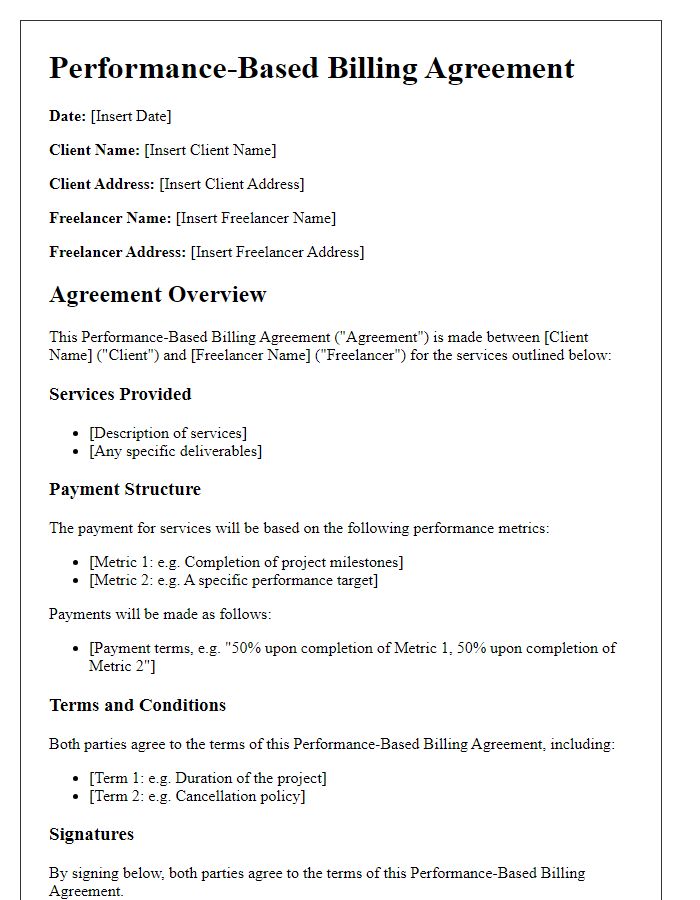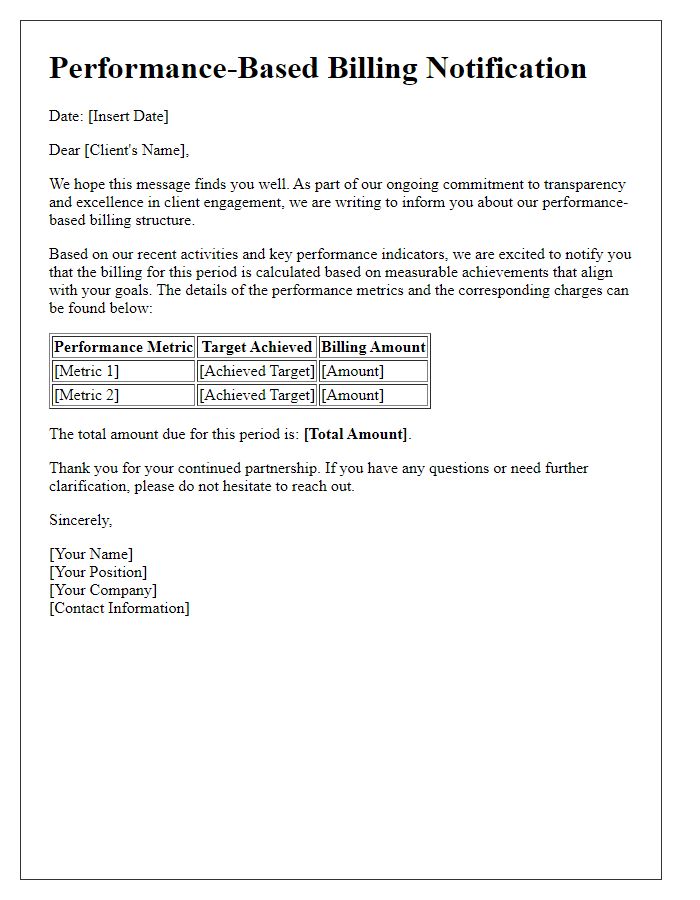Are you curious about how a performance-based billing model can transform your business relationships? This innovative approach not only aligns incentives between service providers and clients but also fosters a more transparent and dynamic partnership. By linking fees directly to measurable outcomes, everyone involved can feel more invested in achieving success together. Ready to explore the benefits and potential challenges of this model? Keep reading to discover more!

Clear Definition of Performance Metrics
In a performance-based billing model, clear definition of performance metrics is crucial for transparent financial transactions, especially in industries like marketing and sales. Key performance indicators (KPIs) such as customer acquisition cost, conversion rates, and return on investment must be established to evaluate service effectiveness. For instance, a digital marketing campaign might define successful performance as achieving a 20% increase in website traffic within a three-month period. Additionally, metrics should include benchmarks, such as a required 15% engagement rate on social media platforms like Facebook and Instagram. Regular assessments--monthly or quarterly--should be scheduled to measure these metrics, allowing for adjustments in strategy to optimize outcomes. Performance metrics should also be documented and agreed upon by both parties to ensure alignment on expectations and responsibilities, fostering accountability and trust in the partnership.
Detailed Payment Terms and Schedule
In a performance-based billing model, clear payment terms and schedules are crucial for ensuring mutual understanding and financial clarity. Payment schedules typically align with specific performance milestones, such as project phases, completion of deliverables, or achievement of key performance indicators (KPIs). For example, a 10% initial payment may be requested upon the signing of the contract, followed by incremental payments (e.g., 20% upon completion of preliminary tasks, 30% upon mid-project review, and the final 40% upon project completion and client approval). Additionally, detailed invoicing procedures should be established, including submission timelines (monthly, quarterly) and required documentation (detailed reports, performance metrics). Penalties for late payments may also be outlined, fostering accountability while ensuring that stakeholders remain incentivized for timely performance. Clear definitions of what constitutes satisfactory performance and the related payment trigger points solidify expectations and motivate project teams to achieve desired outcomes.
Performance Review Process
The performance review process in a performance-based billing model emphasizes measurable outcomes and accountability. Key metrics, such as efficiency rates and client satisfaction scores, are systematically assessed during quarterly evaluations. The evaluation framework, usually conducted by a dedicated team, includes quantifiable data such as completion deadlines and error rates to ensure objectivity. Fairness in compensation adjustments relies on transparent benchmarks, allowing stakeholders to understand the correlation between performance and earnings. This systematic approach fosters continuous improvement, aligning the incentive structures of all parties involved with overall organizational goals, ultimately driving success in project delivery and client outcomes.
Dispute Resolution Mechanism
In a performance-based billing model, the Dispute Resolution Mechanism serves as a crucial framework to address conflicts arising from service delivery and compensation. This mechanism may involve formal channels such as mediation or arbitration, ensuring disputes are resolved efficiently. Key elements include defined timelines (usually within 30 days) for raising disputes, along with a dedicated point of contact, typically a contract manager or compliance officer. Documentation requirements may involve performance reports, invoices, and correspondence records to substantiate claims. Clear guidelines ensure appropriate resolution procedures, such as escalation to senior management or external mediators to facilitate impartiality. Regular training sessions enhance stakeholder understanding of this mechanism, promoting smoother conflict resolution while maintaining service quality and contractual compliance.
Client and Provider Responsibilities
In a performance-based billing model, the clarity of roles and responsibilities between client and provider is essential for effective collaboration and accountability. The client, typically a business or organization, is responsible for defining specific performance metrics, such as key performance indicators (KPIs) like sales growth percentage (target: 15% increase annually) or customer satisfaction scores (aiming for 90% positive feedback). This entity must also ensure timely communication and provide necessary resources for the provider to achieve these goals. The provider, usually a service organization or consultant, is accountable for delivering services that meet or exceed the established performance metrics. Responsibilities include regular reporting on project progress, such as monthly updates and quarterly reviews, and making adjustments based on feedback loops to optimize service delivery. Additionally, both parties must agree on a payment structure tied to the achievement of the defined performance outcomes, ensuring a mutually beneficial relationship focused on results.
Letter Template For Performance-Based Billing Model Samples
Letter template of performance-based billing agreement for freelance services

Letter template of performance-based billing proposal for consulting services

Letter template of performance-based billing contract for service-based businesses

Letter template of performance-based billing outline for marketing agencies

Letter template of performance-based billing terms for creative projects

Letter template of performance-based billing framework for software development

Letter template of performance-based billing procedures for project management

Letter template of performance-based billing notification for client engagement






Comments